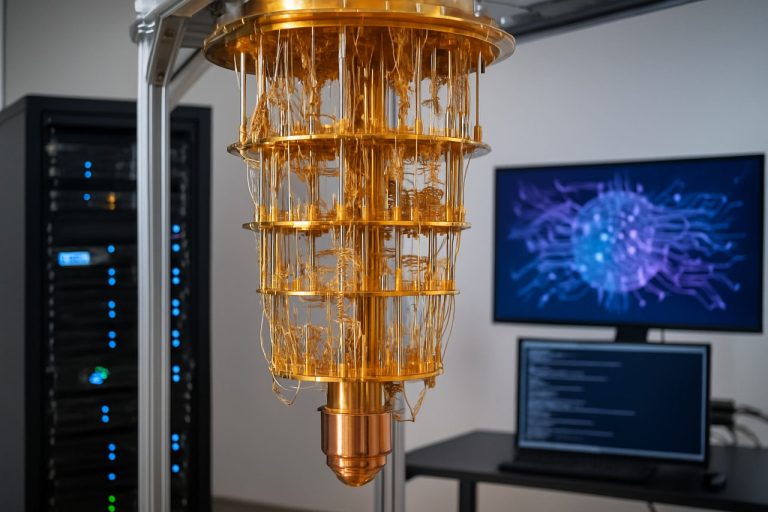
Quasielastic Neutron Scattering: Revealing the Hidden Dynamics of Materials at the Atomic Scale. Discover How QENS Transforms Our Understanding of Molecular Motion and Structure.
- Introduction to Quasielastic Neutron Scattering (QENS)
- Fundamental Principles and Mechanisms
- Experimental Techniques and Instrumentation
- Applications in Material Science and Biology
- Data Analysis and Interpretation Methods
- Recent Advances and Breakthrough Discoveries
- Challenges and Limitations of QENS
- Future Directions and Emerging Trends
- Sources & References
Introduction to Quasielastic Neutron Scattering (QENS)
Quasielastic Neutron Scattering (QENS) is a powerful spectroscopic technique used to investigate the dynamics of atoms and molecules in condensed matter systems on picosecond to nanosecond timescales. By measuring the energy and momentum transfer between incident neutrons and the sample, QENS provides unique insights into diffusive and stochastic motions, such as molecular rotations, translational diffusion, and jump processes. Unlike elastic neutron scattering, which probes static structures, QENS focuses on processes that cause small energy changes in the scattered neutrons, typically less than a few meV, corresponding to the timescales of molecular motions relevant in soft matter, biological systems, and complex fluids.
The technique exploits the sensitivity of neutrons to hydrogen atoms, making it particularly valuable for studying hydrogen-rich materials, including polymers, proteins, and water. QENS experiments are typically conducted at large-scale neutron facilities using time-of-flight or backscattering spectrometers, which allow for high-resolution measurements of energy transfer. The resulting spectra are analyzed to extract information about the nature and rates of atomic and molecular motions, often using models such as jump diffusion or rotational diffusion.
QENS has become an indispensable tool in fields ranging from materials science to biology, enabling researchers to correlate microscopic dynamics with macroscopic properties such as viscosity, conductivity, and mechanical strength. For further details on the principles and applications of QENS, see resources from the Institut Laue-Langevin and the Neutron Sources network.
Fundamental Principles and Mechanisms
Quasielastic Neutron Scattering (QENS) is a powerful technique for probing atomic and molecular motions on picosecond to nanosecond timescales and over nanometer length scales. The fundamental principle of QENS lies in the interaction between incident neutrons and the dynamic components of a sample. When neutrons scatter from a sample, the energy transfer is typically very small—on the order of the thermal energy of the system—resulting in a broadened energy distribution around the elastic peak. This broadening, termed “quasielastic,” arises from stochastic processes such as diffusion, rotational motions, and other relaxational dynamics within the material.
The mechanism of QENS is rooted in the conservation of energy and momentum during neutron-sample interactions. Neutrons, being electrically neutral, penetrate deeply into matter and are particularly sensitive to hydrogen atoms due to their large incoherent scattering cross-section. This makes QENS especially suitable for studying hydrogenous materials, including biological macromolecules, polymers, and liquids. The measured quasielastic broadening in the neutron energy spectrum is directly related to the time-dependent correlation functions of atomic positions, providing quantitative information about diffusion coefficients, jump lengths, and relaxation times.
Experimentally, QENS is typically performed using time-of-flight or backscattering spectrometers at neutron research facilities such as the Institut Laue-Langevin and the Oak Ridge National Laboratory. The data analysis involves modeling the observed spectra with theoretical functions that describe the underlying motion, such as Lorentzian profiles for simple diffusion or more complex models for confined or anisotropic dynamics. Thus, QENS provides a unique window into the microscopic mechanisms governing material behavior at the atomic scale.
Experimental Techniques and Instrumentation
Quasielastic Neutron Scattering (QENS) experiments rely on specialized instrumentation designed to probe atomic and molecular motions on picosecond to nanosecond timescales. The core component of a QENS experiment is a neutron source, typically a research reactor or a spallation source, which provides a high flux of neutrons with suitable energies. Neutrons are moderated to thermal or cold energies, as these are most effective for studying diffusive motions in materials.
The experimental setup includes a monochromator to select neutrons of a specific incident energy, and a sample environment that can control temperature, pressure, or other relevant parameters. After interacting with the sample, scattered neutrons are analyzed by a detector array, which measures both the energy and momentum transfer. The energy resolution of the spectrometer is crucial, as QENS signals are characterized by small energy shifts (typically less than 1 meV) due to the dynamic processes under investigation.
Two main types of spectrometers are used: time-of-flight (TOF) and backscattering spectrometers. TOF instruments, such as those at the Institut Laue-Langevin, measure the time it takes for neutrons to travel from the source to the detector, allowing precise determination of energy changes. Backscattering spectrometers, like those at the Oak Ridge National Laboratory, achieve even higher energy resolution by exploiting Bragg reflection at near-180° angles.
Advances in detector technology, data acquisition systems, and sample environments have significantly enhanced the sensitivity and versatility of QENS experiments, enabling studies of increasingly complex systems, from biological macromolecules to advanced functional materials ISIS Neutron and Muon Source.
Applications in Material Science and Biology
Quasielastic Neutron Scattering (QENS) has emerged as a powerful technique for probing atomic and molecular dynamics in both material science and biological systems. In material science, QENS is extensively used to investigate diffusion processes, rotational motions, and relaxation phenomena in a variety of materials, including polymers, glasses, and hydrogen storage materials. For example, QENS enables the direct measurement of self-diffusion coefficients in solid-state electrolytes, which is crucial for the development of advanced batteries and fuel cells. The technique’s sensitivity to hydrogen atoms makes it particularly valuable for studying proton conduction mechanisms in fuel cell membranes and the dynamics of water in confined environments such as nanoporous materials Institut Laue-Langevin.
In the realm of biology, QENS provides unique insights into the internal motions of proteins, lipid membranes, and other biomolecules on picosecond to nanosecond timescales. This information is essential for understanding fundamental biological processes such as enzyme catalysis, protein folding, and membrane transport. QENS studies have revealed how hydration water dynamics influence protein flexibility and function, and how lipid bilayer dynamics are modulated by temperature and composition. These findings have significant implications for drug design, disease understanding, and the development of biomimetic materials National Institute of Standards and Technology.
Overall, QENS bridges the gap between structure and dynamics, offering a non-destructive and highly sensitive approach to studying the microscopic motions that underpin material properties and biological function.
Data Analysis and Interpretation Methods
Data analysis and interpretation in quasielastic neutron scattering (QENS) are critical for extracting meaningful information about atomic and molecular dynamics from experimental spectra. The raw data typically consist of neutron counts as a function of energy transfer and momentum transfer, which must be corrected for background, detector efficiency, and instrumental resolution. The central step involves deconvoluting the measured spectra with the instrument’s resolution function, often determined from a vanadium standard or a sample at very low temperature where dynamics are frozen.
The resulting dynamic structure factor, S(Q,ω), is analyzed using theoretical models that describe the motion of atoms or molecules. Common approaches include fitting the spectra with Lorentzian or stretched exponential functions, which correspond to different types of diffusive or relaxational processes. The width of the quasielastic peak provides direct information about the timescale of motion, while its Q-dependence reveals the geometry and mechanism of diffusion, such as jump diffusion or confined motion. Advanced analysis may employ the Fourier transform of S(Q,ω) to obtain the intermediate scattering function, I(Q,t), offering a time-domain perspective.
Model selection and parameter extraction are typically performed using least-squares fitting routines, with statistical criteria such as the reduced chi-squared guiding the quality of fit. Modern QENS analysis often leverages software packages like Mantid Project and LAMP (Institut Laue-Langevin), which provide robust frameworks for data reduction, resolution convolution, and model fitting. Interpretation of results requires careful consideration of sample environment, multiple scattering, and potential contributions from rotational, translational, or vibrational motions, ensuring that the extracted dynamical parameters accurately reflect the underlying physical processes.
Recent Advances and Breakthrough Discoveries
Recent years have witnessed significant advances in the field of quasielastic neutron scattering (QENS), driven by both technological improvements in neutron sources and detectors, as well as by innovative experimental and analytical methodologies. The advent of high-flux spallation neutron sources and upgrades to reactor-based facilities have enabled measurements with unprecedented temporal and spatial resolution, allowing researchers to probe molecular motions on timescales from picoseconds to nanoseconds and over a wide range of length scales. These capabilities have been crucial for studying complex systems such as biological macromolecules, polymers, and confined fluids, where subtle dynamical processes are often key to function and performance.
One notable breakthrough has been the application of QENS to investigate protein dynamics in vivo, providing insights into the role of hydration and internal flexibility in biological activity. For example, studies at facilities like the Institut Laue-Langevin and the Oak Ridge National Laboratory have revealed how water-protein interactions modulate enzymatic function and stability. Additionally, the integration of QENS with complementary techniques such as molecular dynamics simulations and nuclear magnetic resonance has enabled a more comprehensive understanding of diffusive and rotational motions in soft matter and energy materials.
Recent methodological advances include the development of polarization analysis and time-of-flight spectrometers, which have improved the discrimination between coherent and incoherent scattering contributions. This has allowed for more precise characterization of collective versus single-particle dynamics, particularly in systems with complex or heterogeneous environments. As a result, QENS continues to play a pivotal role in elucidating the microscopic mechanisms underlying material properties and biological processes, with ongoing developments promising even greater impact in the coming years.
Challenges and Limitations of QENS
Quasielastic Neutron Scattering (QENS) is a powerful technique for probing atomic and molecular dynamics on picosecond to nanosecond timescales. However, several challenges and limitations affect its application and interpretation. One significant limitation is the requirement for large sample volumes, as neutron sources are inherently less intense than X-ray sources. This restricts QENS studies to materials that can be synthesized or obtained in sufficient quantities, and often precludes the study of rare or precious samples Institut Laue-Langevin.
Another challenge lies in the complexity of data analysis. QENS spectra often contain overlapping contributions from different dynamic processes, such as translational and rotational motions, or from multiple components in complex systems. Deconvoluting these contributions requires sophisticated modeling and assumptions, which can introduce uncertainties or ambiguities in the interpretation ISIS Neutron and Muon Source.
Instrumental limitations also play a role. The energy resolution of QENS instruments, typically in the range of micro- to milli-electronvolts, sets the accessible timescale and may not capture faster or slower dynamics. Additionally, background scattering from sample environments or incoherent scattering from hydrogen can obscure weak quasielastic signals, particularly in biological or hydrogen-rich samples Neutron Sources.
Finally, the need for access to large-scale neutron facilities, which are limited in number worldwide, can restrict the availability of QENS experiments. Scheduling, travel, and competition for beamtime further constrain research opportunities, making QENS a less accessible technique compared to laboratory-based methods.
Future Directions and Emerging Trends
Quasielastic Neutron Scattering (QENS) continues to evolve, driven by advances in neutron source technology, detector sensitivity, and computational modeling. One significant future direction is the development of high-brightness neutron sources, such as the European Spallation Source, which promise increased flux and improved time resolution. These enhancements will enable the study of faster and more subtle dynamical processes in complex systems, including biological macromolecules and energy materials European Spallation Source.
Emerging trends also include the integration of QENS with complementary techniques, such as nuclear magnetic resonance (NMR) and molecular dynamics simulations. This multimodal approach allows for a more comprehensive understanding of molecular motions across different timescales and length scales, bridging the gap between experimental observations and theoretical models Institut Laue-Langevin.
Machine learning and artificial intelligence are increasingly being applied to QENS data analysis, facilitating the extraction of meaningful dynamical parameters from large and complex datasets. These tools can accelerate the interpretation of results and uncover hidden patterns in molecular dynamics National Institute of Standards and Technology.
Additionally, there is a growing interest in in situ and operando QENS experiments, which allow researchers to probe dynamic processes under realistic environmental conditions, such as during catalysis or battery operation. This trend is expected to expand the applicability of QENS to a broader range of scientific and industrial challenges, further cementing its role as a vital tool in the study of molecular dynamics.
Sources & References
- Institut Laue-Langevin
- Neutron Sources
- Oak Ridge National Laboratory
- ISIS Neutron and Muon Source
- National Institute of Standards and Technology
- Mantid Project
- European Spallation Source



